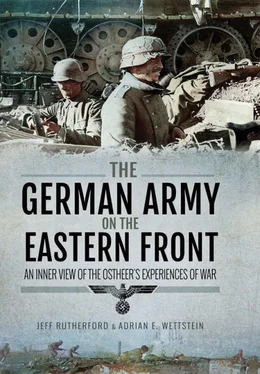b) Given that the troops have had no bath – or washing facility for 2½ months, they are completely ridden with lice.
c) 60% are afflicted with scabies, 20% have lower leg abscesses or extensive cellular tissue inflammations.
d) Under normal circumstances, 25% of the fighting troops must undergo military hospital treatment for 3–4 weeks.
e) The combat power suffers from complete physical exhaustion. It has been detected several times, that individual soldiers were no longer responsive or their drive for self-preservation was completely extinct.
Under these circumstances, the increasing breakdown of the German army’s morale from late 1943 on is not so surprising.
Even working under the over-optimistic presumption of a short campaign, German supply means were barely adequate. When the Blitzkrieg approach failed and the war in the east turned into a long-lasting one of attrition, the German supply system could not cope with the demands placed on it.
Two issues connected to the logistics of the German armies in the east have still to be discussed. First, in hopes of lowering the demands on the supply system, the German military leadership planned for the troops to live off the land. This would significantly reduce the amount of rations and thereby relieve the means of supply. Second, the supply system strongly relied on safe lines of communication, which were all the more important in consideration of all of the deficiencies previously discussed. Both issues are closely connected to German occupation policy, the focus of the following chapter.
Chapter 5
The Occupied Rear: Pacification, Exploitation and Mobilization
Since Operation Barbarossa’s Blitzkrieg was designed to crush the Soviet Union within a brief period of time, the German army put very little thought into designing an occupation regime. Once all Soviet resistance had been smashed by the German army within the three-month period calculated by the high command, both the army and Hitler expected that administrative power would be immediately turned over to civilian authorities. Focused on achieving such a quick and decisive victory and expecting support from SS formations in eliminating resistance in the rear, the army dispatched a mere nine security divisions – three to each army group – to pacify its rear area. In the summer and autumn of 1941, these units had already proved to be unable to fulfil their mission, and the failure to destroy the Soviet Union in one blitz campaign forced the army to create an ad hoc occupation policy in early 1942 that continued to evolve throughout the course of the war. [1]
Army practice shifted between callous neglect, violent coercion and calculated conciliation from 1941 to 1944. Despite it never achieving a unified policy that guided its actions across the expanse of the occupied territories, several guiding themes emerged as early as summer 1941 in the army’s approach that continued throughout the course of the occupation. First, it sought a quiet and pacified rear area in which all traces of resistance and opposition were destroyed. This was necessary for its second objective: the economic exploitation of the region. Working in conjunction with Economic Staff East and other civilian agencies, the army assumed an extremely important role in the devouring of the Soviet Union’s resources, particularly military equipment, raw materials and, most importantly, food. [2]The latter proved decisive in determining the army’s relationship with Soviet civilians. In order to shield the German population from any further cuts in rations and to save what promised to be a strained supply system from delivering large amounts of food to the front, the army was expressly ordered to live off the land. In other words, the fields of the Soviet Union were to provide the army’s sustenance during the campaign. In order to ensure that the Soviet Union provided the necessary materials to not only feed the Eastern army, but also to fuel the global war against Great Britain and an increasingly belligerent United States, the German army prepared for a quick, yet exceedingly violent campaign, which was framed by what historians refer to as the ‘criminal orders’. These directives ranged from regulations governing the relationship between the army and the SS- Einsatzgruppen , utilized to eliminate all manifestations of resistance, particularly from male Jews, to the abrogation of military justice when it came to dealings between soldiers and civilians. The army also issued the commissar order, which demanded the execution of all Soviet political officers captured in battle. [3]Finally, the most important order in determining occupation practices was the ‘Guidelines for the Conduct of the Troops in Russia’. [4]The order began by stating that:
1) Bolshevism is the mortal enemy of the national socialist German Volk . Germany’s struggle is aimed at this subversive Weltanschauung and its carriers.
2) This struggle demands ruthless and energetic action against Bolshevik agitators, guerrillas, Jews and the complete elimination of all active or passive resistance.
3) Extreme reserve and the sharpest care is in order towards all members of the Red Army – including prisoners – as one should expect treacherous combat practices. Especially the Red Army’s Asiatic soldiers are devious, unpredictable, underhanded, and callous.
After discussing the various racial and ethnic groups found in the Soviet Union, it then switched focus and highlighted the economic foundations of the campaign:
8) Economic goods of all types and seized military goods, especially food and fodder, fuel, and articles of clothing are to be saved and secured. All squandering and waste harms the troops. Plundering will be punished with the heaviest penalties according to military law.
Though the army’s period of occupation was deemed to be brief, it was nonetheless based on violence and exploitation.
Within two weeks of the initial invasion, the 7th Infantry Division’s commander released an order that highlighted the importance of the Soviet Union’s raw materials for the Reich. [5]On 5 July 1941, he established the division’s food requisitioning policies to his subordinate commanders:
The General Quartermaster of the Army’s General Staff emphatically points out that, in consideration of the entire food situation of the Reich, the time of unlimited falling back on food supply stocks are over.
The homeland must be relieved wherever it is possible. To protect the stocks in the homeland, as well as to relieve the supply system on the technical grounds of transportation, it is the highest requirement that the troops live extensively ‘ off the land’ . That this is extra work for the troops must be accepted.
In regards to supply from the land, every soldier needs to keep in mind that stocks of captured goods are Wehrmacht stocks that can only be distributed according to the prevailing ration rate . Any wasting and every additional consuming of captured food stocks falls back once again on the supply situation of the homeland.
Captured good depots that cannot be completely exploited by the troops are to be reported to the Divisional [staff section] Ib/IVa and to be guarded until they can be taken over by the division.
The troops must in any case supply themselves with: oats and potatoes .
The division is in any case ready to provide: bread and meat . Self-butchering by the troops is undesirable at this time because the meat provided by the division is then either taken additionally or it remains lying there and spoils. Due to our supply situation, each spoilage of foodstuffs is a sin against the entire [centralized] German food economy. Self-butchering is only necessary when the division can only distribute 1 day’s rations due to the excessive heat.
Читать дальше






![John Stieber - Against the Odds - Survival on the Russian Front 1944-1945 [2nd Edition]](/books/405234/john-stieber-against-the-odds-survival-on-the-russian-front-1944-1945-2nd-edition-thumb.webp)





